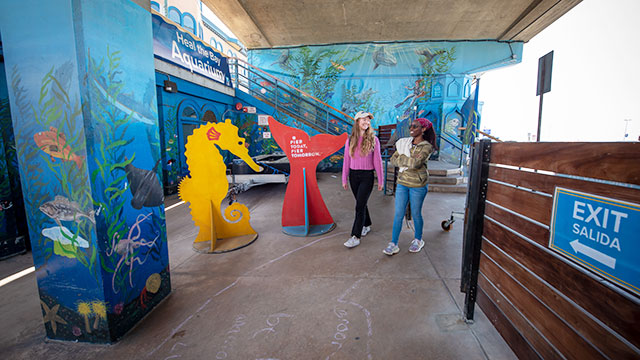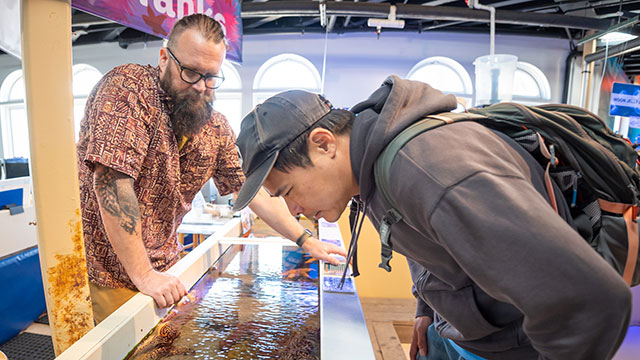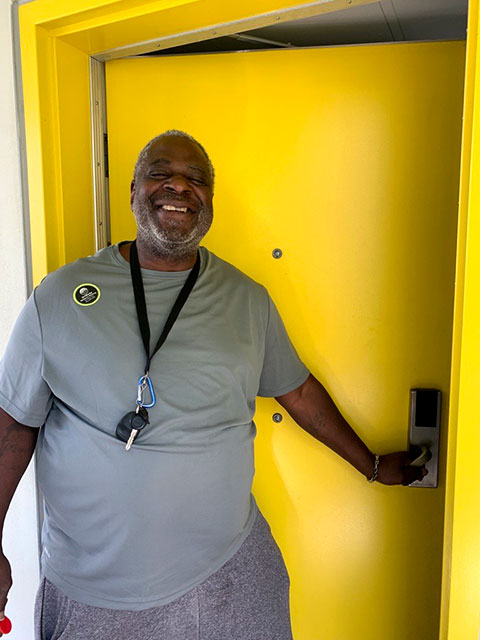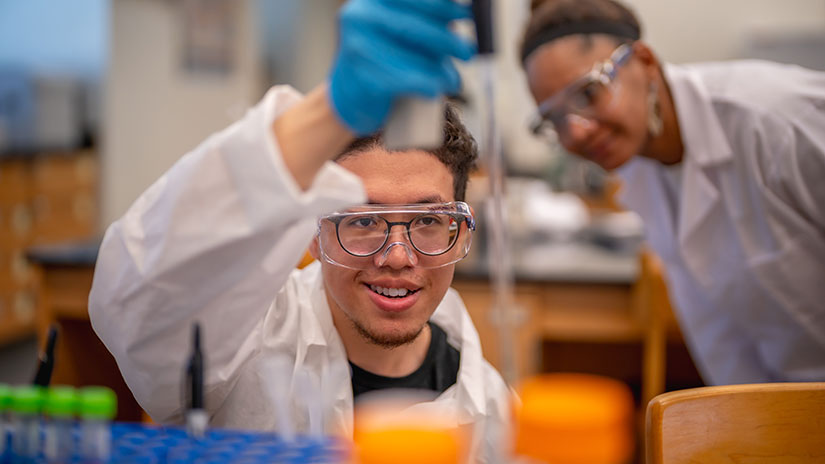Introducing SMC’s latest innovative programs
Spend just a few minutes with the students in Santa Monica College’s new biotechnology program and you’re instantly struck by two things. First is the palpable excitement among the students—not just for the lab work they’re performing at the moment, but also for their futures in the field.
”I want to go into virology,” shares Britney Musa, one of the students. The 23-year-old Los Angeles resident explains what they’re currently exploring in class: virus-like particles that are created in the lab and can deliver lifesaving—and possibly life-changing—solutions. Britney notes how this innovation addresses healthcare challenges where disease-carrying cells disarm the body’s natural immune system.
“I always thought that these cells were almost impossible to fight against because they evolve rapidly,” she adds. “But this makes me hopeful that we can find new ways to help people.”
Another student, Mario Medrano, talks candidly about how the loss of his aunt to cancer set him on the path to being an oncology nurse. But that changed last fall when he learned that SMC was launching a new program in biotechnology, a field Mario had been interested in, but never felt he had access to.
“I discovered a new possibility,” Mario says of the program, which is helping him dream big. He plans on launching his own biotechnology startup someday, and maybe even help develop a cure for cancer. “Not just some cancers,” he adds, “but a treatment that could work for all.”
The other thing you can’t help but notice about the class is who’s in it. Unlike many advanced STEM classes, SMC’s inaugural biotechnology class is remarkably diverse: approximately 30 percent are Black/African American, 25 percent are Latinx, and 25 percent of the students are over age 30.
Those figures are a promising sign of things to come for biotechnology, a field still working to increase diversity in its numbers. Black and Latinx professionals remain underrepresented at every level of the industry compared to their representation in society, as reported recently. And even though women now comprise almost half of employees in the biotechnology field, Black and Latinx women still report significant challenges due to gender and race.
SMC’s Future Oriented Approach to New Careers
Finding one’s passion—that one job that’s perfect for you, the kind that makes you want to jump out of bed in the morning—can feel like a massive undertaking. But what happens when you do find the field of your dreams, only it’s one where you feel like you don’t belong?
Those are the sorts of tough questions that SMC helps students answer, using a future-oriented approach to identifying the most promising new careers. And, just as importantly, mapping out the best path to take to get there.
“That’s our North Star,” says Dr. Patricia Ramos, SMC’s dean of Academic Affairs, who oversees the Office of Workforce and Economic Development. “We want to be certain that students are well-prepared for jobs based on demand and need. So we invest in new program development where it makes sense—in areas where our students will be successful and thrive when they complete a program here at SMC.”
“Every program is unique,” adds Jason Beardsley, SMC vice president of Academic Affairs. “But the common factor for program success is our faculty. They lead the way in developing curriculum for the programs that meet the needs of our students and workforce demands in a given sector.”
He and Dr. Ramos, along with the rest of the Office of Workforce and Economic Development, are making it a priority to collaborate with department chairs, faculty members, and even community partners to get the ball rolling in building out academic programs for potential new careers. The Office acts as a thought partner, offering guidance, research, and support to faculty members seeking to develop a new curriculum or program. This partnership pays off with the creation of fresh, innovative academic programs that focus not just on preparing students for the careers of the future, but also making them easier to reach.
“It’s about creating new opportunities,” notes Steven Sedky, SMC’s interim associate dean for Career Education, “especially for SMC students who are the first in their family to go to college or who come from under-resourced communities. So when we develop new programs, we build in the supports and resources students need to thrive in a given field.”
Aquaculture and the Blue Economy
Innovation also happens not just inside labs, but also out in the field—or, technically, the waters. The ever-expanding “blue economy”—which focuses on the sustainable use of ocean resources for economic growth, improved livelihoods, and jobs—has tremendous potential to impact future generations, with breakthroughs in areas like renewable energy, fisheries, and marine biotechnology. Experts estimate the global blue economy’s value to double to $3 trillion over the next decade.
That growth is creating an increased demand for skilled workers in a range of fields, from living resources to tourism and recreation. Just ask Dr. Alexandra Tower, who served until recently as chair of the SMC Life Sciences Department.
“I recently went to an industry conference,” Dr. Tower recalls, “and many of the people there were talking about how great the industry is. But they also talked about how they’ve been at it since the 1970s. Now they’re ready to entrust their work to the next generation.”
“That’s why we need people now,” adds Dr. Garen Baghdasarian, the current Life Sciences Department chair. “And we’re going to need even more people in the future.”
“This is a two-level certificate program designed to be as broad as possible so students could choose their own path based on what they love,” observes Ferris Kawar, SMC Sustainability Manager. “Certain elements such as entrepreneurship, engineering, or hands-on work underwater—all are part of what we have envisioned.”
In addition to preparing students for this rapidly growing industry, Dr. Tower also hopes the new program will spark greater interest among students historically underrepresented in aquaculture—a field that may seem daunting and alien to many.
“For so many of us, the ocean might as well be another world,” she muses. “So that’s what we’re hoping to accomplish with this program: Make a career in aquaculture less like a dream of another world and more of a reality.”


Careers to Improve Our Communities
The careers of the future aren’t just in STEM fields. In fact, some of the most important and meaningful work is happening outside on the streets, where workers serving the homeless offer support, resources, and hope to unhoused individuals.
 Homeless service workers offer support, resources, and hope.
Homeless service workers offer support, resources, and hope.
Slated to launch this fall, SMC’s Homeless Service Work Certificate Program is designed to prepare students for an entry-level position in the homeless service field. The coursework incorporates an overview of housing policies, as well as an analysis of health equity in the field and best practices in connecting clients to—and helping them navigate through—the many different systems. Students will also gain practical experience through an internship that teams them with frontline workers, and a capstone project where they can hone their new skills while learning how to plan a career path of their own.
The program is the brainchild of Celina Alvarez, executive director of Housing Works of California, and Vanessa Rios, a senior advisor for workforce development at the Los Angeles Homeless Services Authority (LAHSA). Although they’ve been planting the seeds for a program like this for almost a decade, they’re quick to note that the curriculum they’ve developed is a shared labor of love.
“We were the vessels,” notes Rios. “We opened the discussion to frontline workers and others working in the field and asked them: What essential competencies are needed? What kind of education do frontline workers need to thrive? So it really came from those people doing the work.”
“And there’s definitely a need for intensive support and training for those entering this field,” says Alvarez. “This line of work is challenging. The human suffering that frontline workers witness happens far too often.” To address this, the new program features counselors who will mentor and support SMC students during their internships.
What Alvarez and Rios have accomplished is a game-changer for the field. Until now, no college has offered an education program focusing specifically on homeless services. People with degrees who work in the field usually come from social services or psychology—disciplines that, while relevant to homeless services, don’t fully prepare students for the realities and rigors of the work.
“We have people who come in with a lot of heart and a lot of passion,” Alvarez observes. “But they don’t know how to do this work. And so, because they’re doing what they think is the right thing to do, they could wind up causing a lot of harm.”
“It was essential to tap into other sectors,” Rios adds. “Or, in this case, the community college system, to leverage classroom instruction and assist in training individuals before they’re deployed into the field. The other thing we needed was to develop a specialized training program with its own unique curriculum.”
“Frontline workers are committed to helping people experiencing homelessness and they want to do more,” Alvarez explains. “That’s why this program is an opportunity to get the training and education to support career advancement.”
Enrollment in the Homeless Service Work Program will initially be limited this fall to a small group of students recruited earlier this year. But that, Dr. Ramos notes, will likely change in the near future.
Biotechnology and Inclusivity
Occupying the sweet spot among technology, engineering, and biology, biotech has become one of the most exciting frontiers for discovery and innovation today, with groundbreaking advances in areas like drug and vaccine development, biodefense, personalized medicine, and conservation and sustainability. With a wide array of career opportunities, competitive salaries, and the chance to collaborate with the best and brightest minds, biotech offers a unique blend of challenge and reward.
Biotech, like other STEM-centric fields, suffers from a lack of diversity. According to a 2022 report from the Biotechnology Innovation Organization (BIO) – Measuring Diversity in the Biotech Industry: Tracking Progress in Small and Large Companies – African Americans represent only six percent of the biotech and biopharma workforce, while Asian employees make up 21 percent, Hispanic/Latinx employees are seven percent, and Native American employees represent less than one percent.
“I would see all of these diversity initiatives trying to get more inclusivity in STEM and the life science industry,” recalls Dr. Andria Denmon, SMC biology professor and a faculty lead for the Biotechnology Program. “But I always felt like, when I looked around, I didn’t see a lot of people who looked like me. Or if they were in a STEM program, they didn’t stay for very long. And that always bothered me.”
Keck Foundation Grants $1 Million to SMC
So when the W.M. Keck Foundation awarded SMC a $1 million grant to create an equity centered biotechnology program, Dr. Denmon, along with colleague Dr. Thomas Chen, eagerly seized on the opportunity. At the top of their priority list was the creation of a clear pathway to the biotech field, with an emphasis on supporting students from underserved communities. That meant offering a high-quality, immersive learning experience, while also reducing any challenges students might encounter when taking on an internship.
Today, that vision is a reality. The new biotech program offers students two stackable certificate options. The first consists of five introductory courses and an internship leading to immediate entry-level lab tech employment opportunities, while the second features advanced courses covering cell culture and immunoassay methods, microbiology fundamentals, and nano-biotechnology. For students interested in pursuing an Associate degree in Biotechnology, additional courses focusing on quality control and quality assurance issues will be required.
All of this, notes Dr. Denmon, would not have been possible without the involvement of the Keck Foundation, the National Science Foundation, and other generous funders. Thanks to their support, the new biotechnology program was able to secure advanced equipment and supplies, as well as fund student stipends and personnel expenses. Meanwhile, other key partners, such as Santa Monica-based Kite Pharma and biotech giant Amgen, have proven essential in ensuring students get hands-on experience.
“One of our priorities is establishing the infrastructure for internships and part-time jobs for our first-year cohorts,” says Dr. Chen. “We anticipate being able to place students in the company they choose by next summer. This paves the way toward potential employment after the students receive their certificates.”
Kite Pharma Offers Student Internships
Dr. Denmon is most excited about how the program is already breaking down barriers for historically underrepresented students. She notes that one of her biology students was recently tapped for a Kite Pharma internship—a first for any community college student.
“Traditionally, the company only picks students from a bachelor’s program,” she states. “But because of the relationship that we developed with them, they created an internship specifically for SMC students.”
She grins. That internship was so successful that “this time, they’ll have two paid internships available for our students.”
Fieldwork and Internships at Heal the Bay Aquarium
A sense of urgency is what led Dr. Tower, Dr. Baghdasarian, and SMC Sustainability Manager Ferris Kawar to create SMC’s new Aquaculture Program. Launched last spring, the program features a curriculum developed in partnership with AltaSea, a hub for scientific innovation and collaboration in the blue economy. Courses in the program cover marine biology, seawater chemistry, aquaculture system design, and hatchery techniques, and the program includes internships. To foster more employment opportunities for students, the program also features hands-on fieldwork, lab experience, and internships at the Heal the Bay Aquarium.
Translating Passion to Careers
These three programs are just the latest in SMC’s new offerings. In the last few years, the College has launched several focused certificate and degree programs, including e-sports and administration of justice. Faculty and staff are already looking to the future, with a number of new programs that focus on real estate, cloud computing, data science, and cybersecurity. Additionally, a new barbering certificate program will be available to students starting this fall. All this work, Dr. Sedky says, is about finding the best career pathways for students—the occupations that speak to their interests or passions, the ones where there is room to grow and advance.
He adds that none of this would have been possible without people like Denmon, Tower, Alvarez, and all the others who had the vision and determination to make these new programs a reality.
“There’s just a certain type of brilliance,” Dr. Sedky notes, a hint of admiration in his voice. “They put all this hard work into developing these new programs that change the lives and trajectories of our students and create so many amazing opportunities.”



